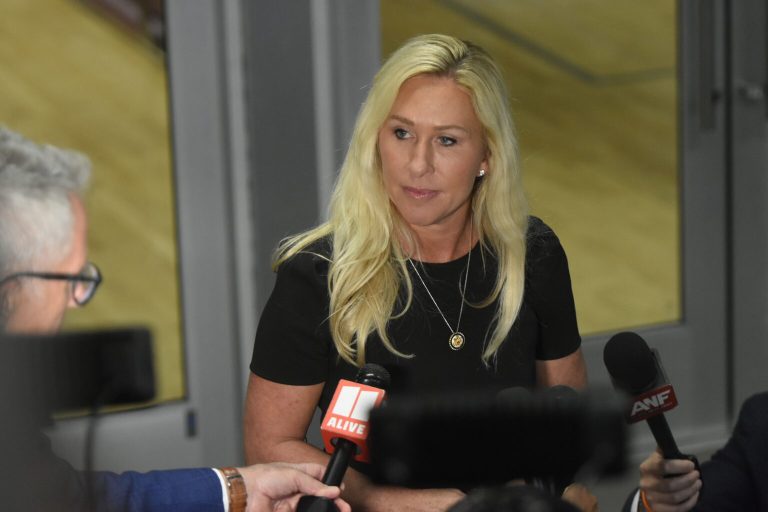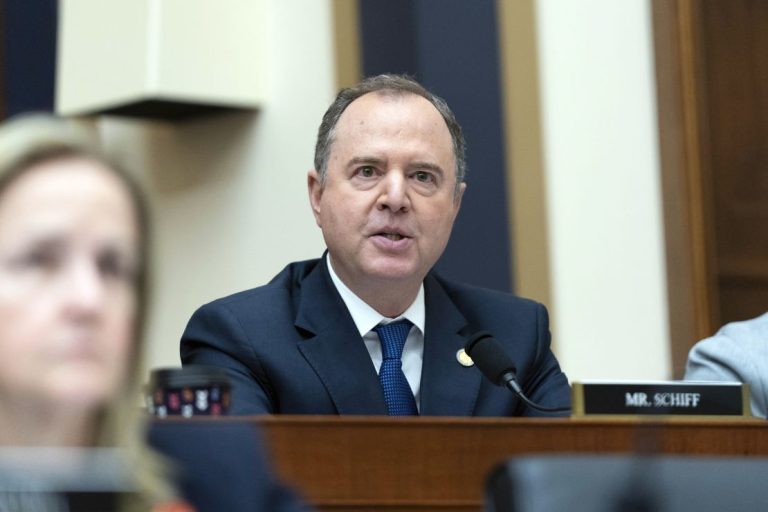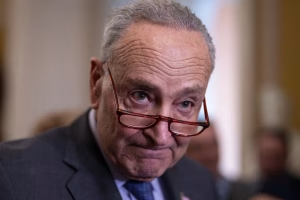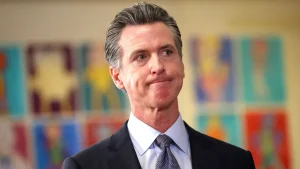A Shutdown That Never Should Have Happened
After 43 long days of political theater, finger-pointing, and cable-news drama, Washington finally blinked. But here’s the twist: it wasn’t Republicans who caved. It wasn’t Speaker Mike Johnson. And it certainly wasn’t President Trump, who held firm from day one.
No — it was Democrats.
The House voted late Wednesday to reopen the government, ending the longest shutdown in U.S. history. The final vote: 222–209. The shocker? A small handful of Democrats broke with Hakeem Jeffries and Chuck Schumer… and sided with Republicans.
That tiny group — just six House Democrats — changed everything.
The White House has already announced President Trump will sign the bill immediately.
And for good reason: he got exactly what he wanted.
The Democrats Who Crossed the Aisle
In a party obsessed with messaging unity, this move was a political earthquake. The six Democrats who voted to reopen the government were:
-
Jared Golden (ME)
-
Adam Gray (CA)
-
Henry Cuellar (TX)
-
Marie Gluesenkamp Perez (WA)
-
Don Davis (NC)
-
Tom Suozzi (NY)
These aren’t fringe members. They’re the Democrats who still have to win in swing districts — the ones who don’t have the luxury of hiding behind Twitter hashtags and MSNBC monologues.
They saw the writing on the wall.
Their voters had had enough.
The shutdown was killing them back home.
So they jumped.
And the Democratic leadership suddenly looked powerless.
The Real Surprise: It Was Never About Policy
For nearly seven weeks, Democrats claimed they were holding out for ACA premium credits and a menu of progressive wish-list items. They pitched it as a moral stand. They marketed it as a fight for “working families.”
But when push came to shove, their top demand — the extension of Obamacare subsidies — isn’t in the bill. Not even close. Republicans refused from day one, and they never budged.
If this was a negotiation, Democrats walked away with lint in their pockets.
The shutdown didn’t force Republicans to move.
It forced Democrats to surrender.
Jeffries Escapes Blame… Somehow
Interestingly, Hakeem Jeffries avoided most of the heat — at least publicly. House Democrats continue to treat him cautiously, like he’s made of glass. But under the surface, the discontent is real.
He led them into a shutdown.
He failed to unify his caucus.
And he ended up voting against the very measure that got them out of it.
Jeffries didn’t win anything.
He simply avoided taking the loudest punch.
The contrast is striking: Democrats were willing to let the government stay closed indefinitely, but six of their own ultimately decided regular Americans mattered more than Jeffries’ pride.
Schumer Takes the Fall
Chuck Schumer wasn’t so lucky. The Democrat base is furious. Progressive activists say he folded. Moderates claim he miscalculated. Even his own members complain he wasn’t communicating.
Sen. John Fetterman said it out loud:
“No one really knows who is leading Democrats in Congress.”
When your own senator admits the party is leaderless, that’s not a gaffe — that’s a diagnosis.
Schumer pushed the shutdown strategy knowing full well his caucus was divided. He assumed Republicans would fracture first.
He was wrong.
Republicans stood united for over 40 days.
Now the Democrats are the ones splintering.
The Truth: This Shutdown Was Over Nothing
Mike Johnson said it clearly:
“It really was a shutdown about nothing.”
And he’s right.
The final bill that reopened the government?
It’s almost identical to what Republicans offered at the very start. The only major difference is the Democrats dragged the country through six weeks of chaos before taking the deal they could’ve accepted on Day One.
It’s almost unbelievable how much pain was caused — for nothing.
-
Federal workers went without pay.
-
Travel delays spread across the country.
-
Food assistance was disrupted for low-income families.
-
The public lost patience.
-
Democrats lost credibility.
And for what?
A negotiation that ended exactly where it began.
The One GOP Member Who Said No
Even on the Republican side, dissent was minimal. Only Rep. Thomas Massie and Rep. Greg Steube voted against the bill. Massie wanted deeper spending reforms. Steube objected to a provision about senators suing the government over seized phone records.
Steube put it bluntly:
“I’m not gonna send Lindsey Graham half a million dollars.”
Even that disagreement wasn’t about the shutdown itself — it was about technical issues buried in the bill.
Meanwhile, Democrats were still fighting over whether to fund the government at all.
A Subtle Turning Point For 2026
Let’s zoom out.
This wasn’t just a funding vote. It was a preview of the next election cycle.
Democrats are losing their grip on their own coalition.
Swing-district members no longer fear leadership.
The progressive wing blames Schumer.
The moderates blame Jeffries.
And voters blame all of them.
The deal also forces the Trump administration to rehire roughly 4,000 federal workers — a move Democrats tried to prevent. It prohibits further reductions until January 30.
In other words:
Trump gets a staffed government.
Democrats get nothing.
And Republican unity becomes the headline.
This is the kind of moment that shapes congressional maps, fundraising, and public confidence heading into 2026.
The White House’s Position
Karoline Leavitt, speaking for the administration, framed the bill as a strategic win. The shutdown had already trimmed down bureaucracy. The rehiring requirement doesn’t undo that long-term goal. And the administration wanted the government reopened — period.
Her message was clear:
The White House stayed focused.
Democrats didn’t.
When you compare leadership styles, the difference is impossible to ignore.
When Democrats Turn on Each Other
What’s fascinating now is who Democrats are blaming.
-
Progressives blame Schumer.
-
Moderates blame the progressive wing.
-
House Democrats quietly grumble that Jeffries is too cautious.
-
Senate Democrats complain Schumer is too aggressive.
-
Governors complain the party has “no message.”
-
And voters? They’re exhausted.
That’s how parties fall apart — not in one dramatic explosion, but in dozens of small cracks forming all at once.
This shutdown revealed those cracks.
And Democrats know it.
The Final Blow
After 43 days, the public wanted answers.
Instead, they learned something uncomfortable:
Republicans had a plan.
Democrats had a tantrum.
And tantrums don’t lead to victories.
The shutdown failed.
Their strategy failed.
Their leaders failed.
And a small group of Democrats finally decided they weren’t going down with the ship.
That’s why this vote matters.
It wasn’t just about funding.
It was the first sign that Democrats are losing control of their own members — and losing the confidence of the country.
If they don’t fix it soon, the 2026 midterms won’t be a fight.
They’ll be a surrender.

James Jenkins is a celebrated Pulitzer Prize-winning author whose work has reshaped the way readers think about social justice and human rights in America. Raised in Atlanta, Georgia, James grew up in a community that instilled in him both resilience and a strong sense of responsibility toward others. After studying political science and creative writing at Howard University, he worked as a journalist covering civil rights issues before dedicating himself fully to fiction. His novels are known for their sharp, empathetic portraits of marginalized communities and for weaving personal stories with broader political realities. Jenkins’s breakout novel, Shadows of Freedom, won national acclaim for its unflinching look at systemic inequality, while his more recent works explore themes of identity, resilience, and the fight for dignity in the face of oppression. Beyond his novels, James is an active public speaker, lecturing at universities and participating in nonprofit initiatives that support literacy and community empowerment. He believes that storytelling is a way to preserve history and inspire change. When not writing, James enjoys jazz music, mentoring young writers, and traveling with his family to explore cultures and stories around the world.









